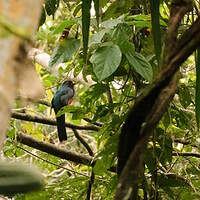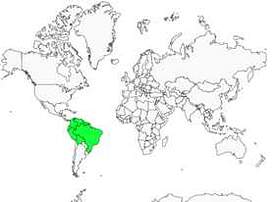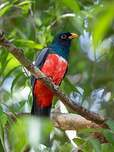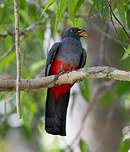Black-tailed Trogon
Trogon melanurus - Trogon à queue noire
Identification
Black-tailed Trogon (Trogon melanurus) is derived from the Greek melanouros, which literally translates to black-tailed. The male Black-tailed Trogon has a striking yellow beak, with an upper mandible that is slightly curved, a black parotid and throat surrounding an orange orbital eye-ring, and a dark brown iris. There are distinct black whiskers around the beak. The base of the forehead is blackish with the second part of the forehead, cap, mantle and back a vivid greenish-emerald color, which may take on navy blue hues depending on the light. The scapulars are green with bronze tinges, the coverts and tertiary remiges all finely spotted with black and white, the alula and lower wing-bar is black, whilst the primaries and secondaries are black with white vertical lines near the marginal edges, which fade away for the completely black hand. The rump is a light turquoise blue at the tip, that transitions to a darkened blue on the upper rectrices, which are bordered by a horizontal black band. The chest is the same green as the back and is bordered by a thin white line from the bright red abdomen, a distinctive mark of the Black-tailed Trogon compared to its closely related cousin, the Massena's Trogon. Finally, the tail is completely black on the lower rectrices, which gives the species its name. The female has a black culmen and yellow under mandible, the orbital eye-ring is still orange, but the coloring is duller than that of its mate. Some females have small white feathers at the back of the eye; Albert Earl Gilbert, an artist who has drawn and painted numerous trogons, believes these feathers are remnants of its juvenile plumage.The Black-tailed Trogon male's emerald green is replaced by a dark grey colour on the mantle and back of the female, lightening in colour on the chest. There is no white separation between the chest and vivid red underside. The upperparts appear completely anthracite and you must get very close in order to be able to distinguish very thin horizontal white-grey waves. Primary flight feathers have the same appearance in both sexes, black with very marked white edgings. Always little-visible tarsi are brown-grey. Juveniles look like adult females, young males beginning to have green shades on the back and chest giving a slightly faded grey-green colour, the upper rectrices having a mixed blue and green tone. Four subspecies are recognized, ssp melanurus which gives its name to the species; ssp macroura, lower back, pale blue rump and upper rectrices, the 'serrations' of the coverts being less fine, female being bigger and having a stronger beak; ssp eumophus with darker coverts, upper rectrices of a deeper blue, the pectoral band being thinner; ssp mesurus like eumorphus, coverts presenting waves less contrasted, alternation of dark grey and white-grey, eye iris being white, female having very pale grey colour.
Subspecific information 3 subspecies
- Trogon melanurus melanurus (e Colombia to the Guianas south to n Bolivia and e Brazil)
- Trogon melanurus macroura (e Panama, n Colombia)
- Trogon melanurus eumorphus (w Amazonia)
Foreign names
- Trogon à queue noire,
- Trogón colinegro común,
- surucuá-de-cauda-preta,
- Schwarzschwanztrogon,
- feketefarkú trogon,
- Zwartstaarttrogon,
- Trogone codanera,
- svartstjärtad trogon,
- Svarthaletrogon,
- trogón čiernochvostý,
- trogon zelenopláštíkový,
- Sorthalet Trogon,
- mustapyrstötrogoni,
- trogon cuanegre comú,
- trogon czarnosterny,
- Чернохвостый трогон,
- クビワオグロキヌバネドリ,
- 黑尾美洲咬鹃,
- svartstjärtad trogon,
- 黑尾美洲咬鵑,
Voice song and call
His singing is quite similar to the Massena's trogon's that let out a plaintive koh-koh-koh-koh. The Black-tailed Trogon produces a louder kwoo-kwoo-kwoo-kwoo, in series of 25 notes, observations revealed they can have up to 46 vocalisations! It can sometimes seem like a puppy's bark.
Habitat
The Black-tailed Trogon appears to be highly adaptable, being found in Panama's secondary forests, tropical wet forests, and even in the mangroves near the Caribbean sea. It has been observed at heights up to 2,200 m in Colombia, and in Amazonia can be found in both the canopy and the understory of the terra firme, which is the part of the Amazonian forest that does not flood.
Behaviour character trait
Dietfeeding habits
Reproduction nesting
The Black-tailed Trogon breeds from March in Panama, from January to May in Colombia, July to October in Guyana, and June to July in the Amazon.
It most commonly builds its nest in an old arboreal termite mound constructed in large palm trees, such as Scheelia or Astrocaryum, or make use of a cavity in a tree. The couple digs a tunnel about 7-8 cm in diameter and 19-20 cm in length, sloping at an average angle of 56°, leading to a chamber about 18 cm in diameter and 15 cm long. The clutch size is usually 2-3 eggs, but there is currently no information on the incubation and chick-rearing period.Geographic range
Black-tailed Trogon Ssp melanurus (from Colombia, Venezuela, Guyana, Surinam, French Guiana) - Ssp macroura (Panama, northern Colombia and northwest Venezuela) - Ssp mesurus (western Ecuador and northwest Peru) - Ssp eumophus (in the Amazon basin, north and central Brazil, northern Bolivia).
Threats - protection
IUCN conservation status
concern
in the Wild
threatened
evaluated
There does not seem to be a decline in the Black-tailed Trogon's (LC) population, but deforestation, population expansion and the use of pesticides still pose a risk to all Trogonidae.
Sources of information
- IOC World Bird List (v15.1), Gill, F and D Donsker (Eds). 2025-12-07.
- A Natural history of the Trogonidae, Joseph M.Forshaw Albert Earl Gilbert
- Vol. 6 - Handbook of the Birds of the World, Josep del Hoyo-Andrew Elliott-Jordi Sargatal
- The Birds of Panama, George R.Anger Robert Dean
- xeno-canto, Sharing bird sounds from around the world,
- Avibase, Lepage Denis
- Arthur Grosset's Birds, Arthur Grosset
- BirdLife International, BirdLife International
- Wikipédia, Wikipedia, The Free Encyclopedia
Other sources of interest
 Specification sheet created on
01/08/2023 by Anne et Gabriel Leboff
Specification sheet created on
01/08/2023 by Anne et Gabriel LeboffTranslation by AI Oiseaux.net
© 1996-2025 Oiseaux.net
- Accipitriformes
- Aegotheliformes
- Anseriformes
- Apodiformes
- Apterygiformes
- Bucerotiformes
- Caprimulgiformes
- Cariamiformes
- Casuariiformes
- Charadriiformes
- Ciconiiformes
- Coliiformes
- Columbiformes
- Coraciiformes
- Cuculiformes
- Eurypygiformes
- Falconiformes
- Galliformes
- Gaviiformes
- Gruiformes
- Leptosomiformes
- Mesitornithiformes
- Musophagiformes
- Nyctibiiformes
- Opisthocomiformes
- Otidiformes
- Passeriformes
- Pelecaniformes
- Phaethontiformes
- Phoenicopteriformes
- Piciformes
- Podargiformes
- Podicipediformes
- Procellariiformes
- Psittaciformes
- Pterocliformes
- Rheiformes
- Sphenisciformes
- Steatornithiformes
- Strigiformes
- Struthioniformes
- Suliformes
- Tinamiformes
- Trogoniformes






























